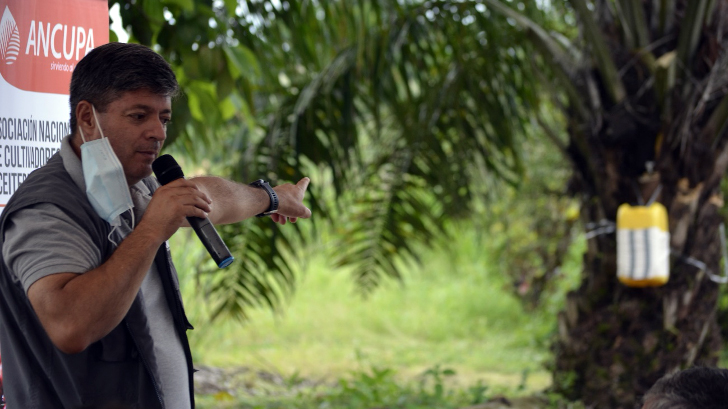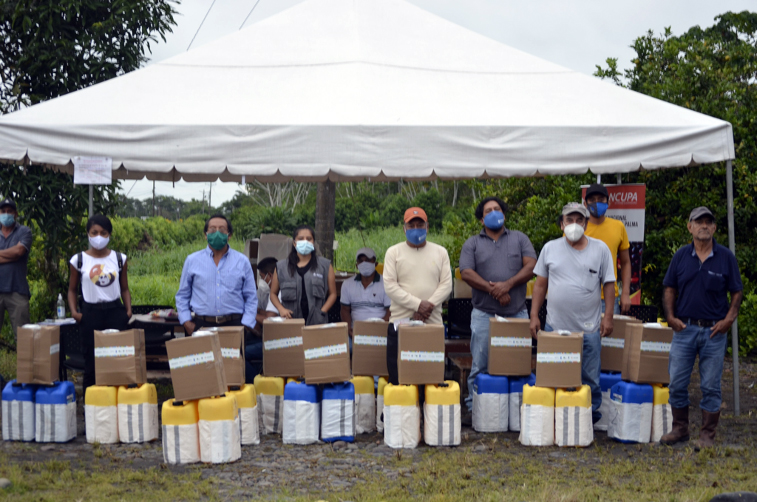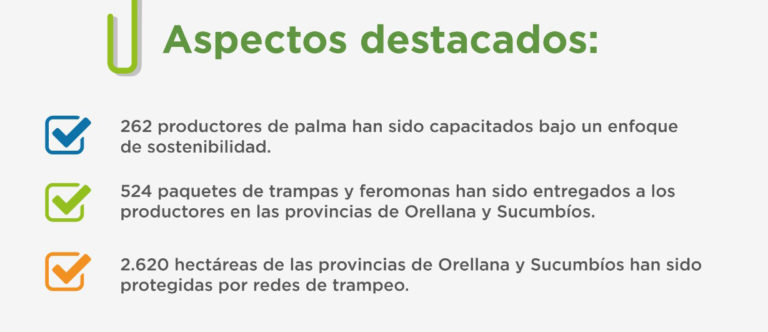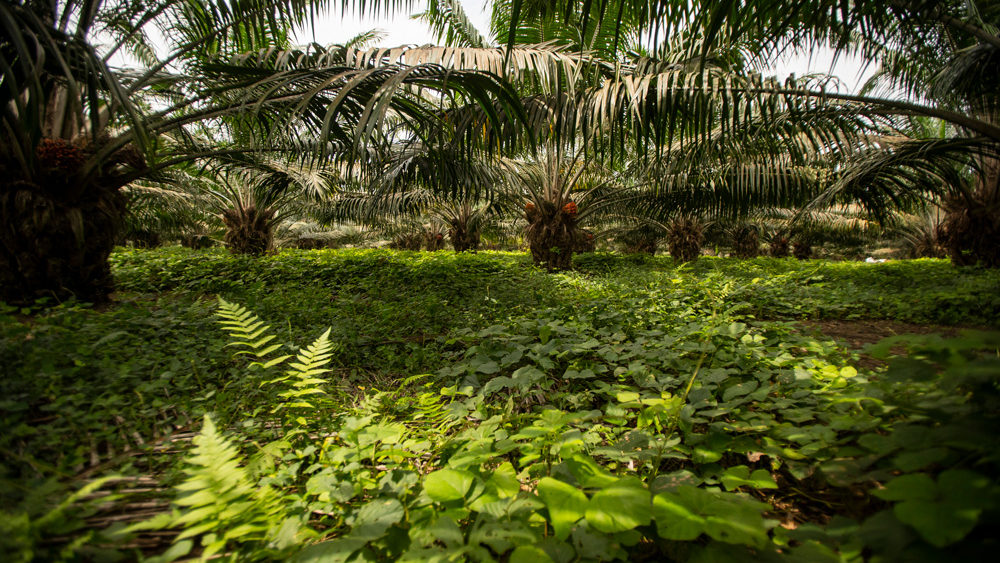Since the early 1980s, oil palm has become one of the main crops in the provinces of Orellana and Sucumbíos, located in the northern part of the Ecuadorian Amazon. According to a study carried out by PROAmazonía, with the support of the General Coordination of National Agricultural Information (CGINA), the Ministry of Agriculture and Livestock and the Observatory for Foreign Trade (OCE), there are currently 35,262.84 hectares planted with this crop, on which 971 producer families depend and which generate around 10,000 jobs.
“Thank God that I was able to plant a few hectares of palm (…) I am happy and grateful to be able to have this product that now allows us to move forward” says Zenaida Arias, who has cultivated 10 hectares of palm for 11 years in the Luz de América Community, from the Shushufindi canton in the Sucumbíos province.
Photography: PROAmazonía archive images
Description: Zenaida Arias, palm grower from the Luz de América Community, Sucumbíos province.
Within the study conducted by PROAmazonía, a program led by the Ministry of Environment and Water and the Ministry of Agriculture and Livestock with the support of UNDP, a survey was conducted on a sample of 332 palm plantations, which led to the conclusion that palm cultivation, despite occupying 39% of the producers’ planted area, represents on average 75% of their income, being the main economic activity of 92% of those surveyed.
Unfortunately, the same study revealed that currently 86% of these plantations are affected by phytosanitary problems. Among the problems identified were surprise wilt, bud rot and red ring. Even though the incidence of these problems is low at the moment, the presence of these factors puts at risk the main means of livelihood of these people.
With this reality in mind, as of November 10, 2020, PROAmazonía, together with the National Association of Oil Palm Growers (ANCUPA), is implementing a program to strengthen the capacities of palm growers in the region. The objective is to promote the application of good agricultural practices with a focus on sustainability and deforestation-free production.
One of the actions implemented within this program is the establishment of a trapping network for the management of Rhynchophorus Palmarum, an insect known locally as gualpa or palm weevil, which has been responsible for the loss of thousands of hectares of plantations nationwide. This insect affects the crop in three different ways:
Their larvae bore into the internal tissues of the plant, causing damage to the growth meristem, which can cause the death of the palm and/or facilitate the development of pathogens such as fungi and bacteria.
In plants affected by Bud Rot (BR), the females deposit their eggs in the affected tissues, which become a substrate for the development of the different larval stages that, when feeding, in many cases cause the plant to die.
It is the vector of the nematode Bursaphelenchus cocophilus, which causes the lethal disease known as Red Ring.
The presence of gualpa is related to two of the main phytosanitary affectations present in crops in the region and plays a limiting role in oil palm productivity. This can cause the loss of up to 35% of production plants, drastically reducing production and consequently the profitability of this activity. The ideal way to control them is to establish a trapping network.
“Trapping for Rhynchophorus palmarum, is one of the good agricultural practices, of great importance for the sustainability of oil palm cultivation” indicates Rafael Chiriboga, Technical Coordinator of ANCUPA, adding that “according to the 2017 palm census, it was determined that in the province of Orellana there is presence of black palm weevil in 69% of the estates cultivated with oil palm and only 28% of them are trapped.” He also mentioned that: “in the Sucumbíos province there is a presence in 57% of the properties and trapping is carried out in 27%. Trapping is carried out to monitor the presence of the pest and to control its population.”

Photography: Courtesy of ANCUPA
Description: Rafael Chiriboga, Technical Coordinator of the National Association of Oil Palm Growers – ANCUPA, giving workshops on Gualpa control in the province of Orellana.
Trapping can be carried out individually, but if it is implemented in groups by sectors or zones, the trapping network is built, a factor that increases the efficiency in the control of populations of this insect, reduces the cost of implementation and maintenance of the traps. For this to be possible, all producers in the region are required to commit to the activity and have the necessary inputs for implementation.
To date, PROAmazonía has delivered 524 traps and packages of aggregation pheromones for the installation of the trapping network, and, with the support of ANCUPA, has held 11 training workshops to strengthen the knowledge of 262 producers. At the end of the project, 904 palm growers are expected to be trained in gualpa control and a network of about 3,000 traps is expected to be set up, covering at least 30% of the cultivated area in the region.
One aspect to highlight is that the investment for the establishment of the trapping network is around USD 2.00 per hectare, and its annual maintenance has a cost of USD 1.30. This small investment protects the crop, which produces an average of 12.2 tons of fruit per hectare per year. This represents annual income of around USD 1,500, during a production cycle of at least 25 years.
This cost-benefit ratio makes it a practice that can be assimilated by producers, who have reacted positively. “The technicians are always visiting us and guiding us, that’s the most important thing, we don’t have much technical knowledge, and we need their support,” says Zenaida Arias.
It is too early to know the positive impact of this activity, but based on experiences in other regions, it is expected to reduce the population of gualpas within the plantations, reduce mortality caused by Bud Rot and eliminate mortality caused by red ring in the region’s plantations.
Note: PROAmazonía provides technical assistance to producers through field schools, which teach knowledge related to sustainable, deforestation-free production. The objective of the program is to promote sustainable production and advise those who already have palm plantations to optimize their land, using environmentally friendly agricultural practices that are more efficient, in order to avoid the expansion of the agricultural frontier.

Photography: Courtesy of Ancupa
Description: Program beneficiaries receiving the traps during the Rhynchophorus Palmarum management workshop.

Author: Santiago Rosero – PROAmazonía Sustainable Palm Technician
 Español
Español English
English
